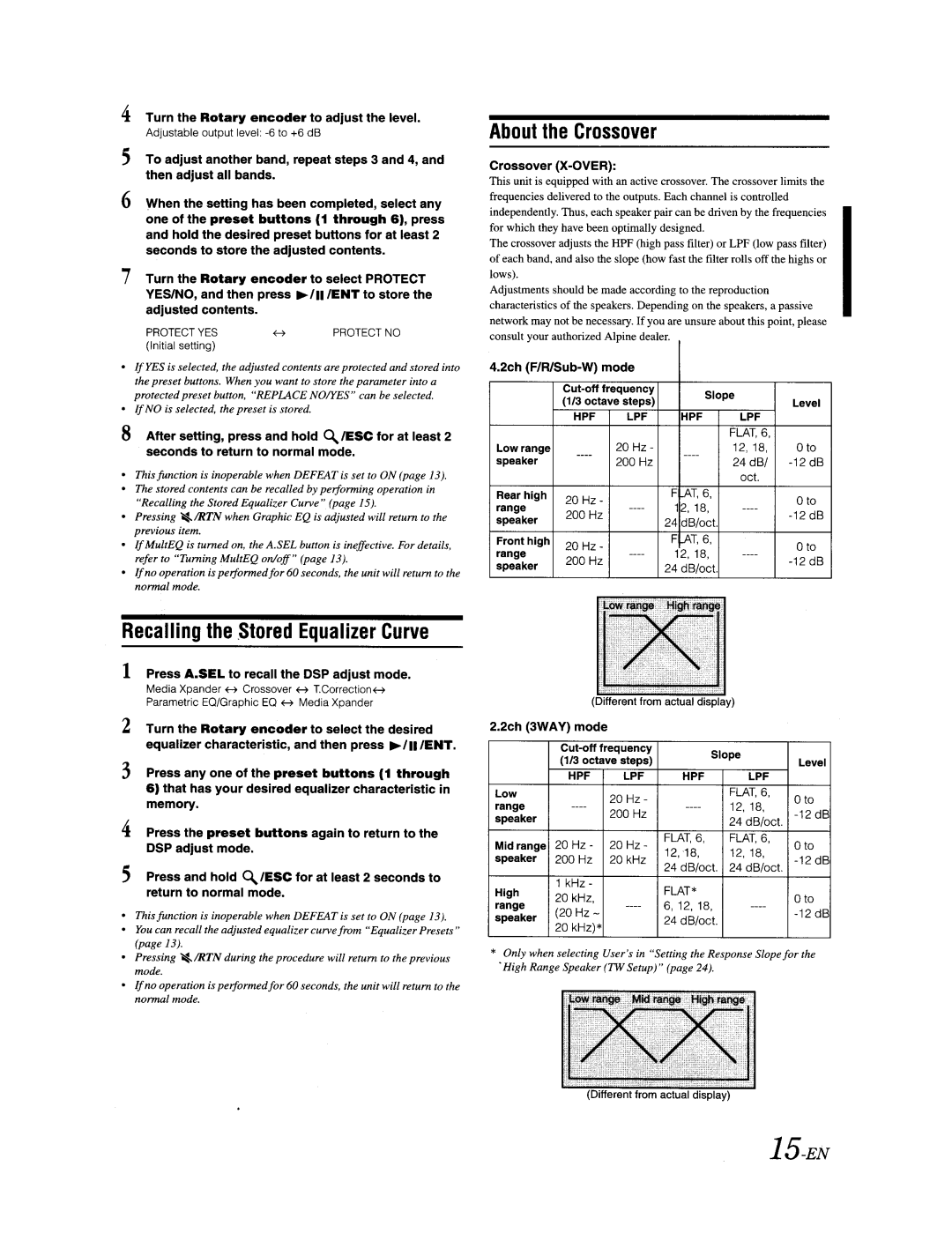
4 Turn the Rotary encoder to adjust the level.
Adjustable output level:
5 To adjust another band, repeat steps 3 and 4, and then adjust all bands.
6 When the setting has been completed, select any one of the preset buttons (1 through 6), press and hold the desired preset buttons for at least 2 seconds to store the adjusted contents.
7 Turn the Rotary encoder to select PROTECT YES/NO, and then press ~/II/ENTto store the adjusted contents.
PROTECT YES | PROTECT NO |
(Initial setting) |
|
•If YES is selected, the adjusted contents are protected and stored into the preset buttons. When you want to store the parameter into a protected preset button, "REPLACE NO/YES" can be selected.
•If NO is selected, the preset is stored.
8 After setting, press and hold ~/ESefor at least 2 seconds to return to normal mode.
•This function is inoperable when DEFEAT is set to ON (page 13).
•The stored contents can be recalled by peiforming operation in "Recalling the Stored Equalizer Curve" (page 15).
•Pressing ~ IRTN when Graphic EQ is adjusted will return to the previous item.
•If MultEQ is turned on, the A.SEL button is ineffective. For details, refer to "Turning MultEQ on/off" (page 13).
•Ifno operation is peiformedfor 60 seconds, the unit will return to the normal mode.
About the Crossover
Crossover (X-OVER):
This unit is equipped with an active crossover. The crossover limits the frequencies delivered to the outputs. Each channel is controlled independently. Thus, each speaker pair can be driven by the frequencies for which they have been optimally designed.
The crossover adjusts the HPF (high pass filter) or LPF (low pass filter) of each band, and also the slope (how fast the filter rolls off the highs or lows).
Adjustments should be made according to the reproduction characteristics of the speakers. Depending on the speakers, a passive network may not be necessary. If you are unsure about this point, please consult your authorized Alpine dealer
4.2ch (F/R/Sub-W) mode
| Slope |
| |||||
| (1/3 octave steps) | Level | |||||
|
|
| |||||
| HPF | LPF | HPF | LPF |
| ||
|
|
|
|
| FLAT, 6, | oto | |
Low range | 20 Hz- | 12,18, | |||||
speaker | 200 Hz | 24 dB/ | |||||
|
|
| |||||
|
|
|
|
| oct. |
| |
Rear high | 20 Hz- | FAT,6, |
| Oto | |||
range | 12,18, | ||||||
200 | Hz | ||||||
speaker |
| 24 dB/oct. |
| ||||
|
|
|
|
| |||
Front high | 20 Hz- |
| F AT, 6, |
| Oto | ||
range | 12,18, | ||||||
200 | Hz | ||||||
speaker |
| 24 dB/oct. |
| ||||
|
|
|
|
| |||
Recalling the ,Stored Equalizer Curve
1 Press A.SEL to recall the DSP adjust mode.
Media Xpander H Crossover H TCorrectionH
Parametric EO/Graphic EO H Media Xpander
2 Turn the Rotary encoder to select the desired equalizer characteristic, and then press ~ III lENT.
3 Press anyone of the preset buttons (1 through
6)that has your desired equalizer characteristic in memory.
4 Press the preset buttons again to return to the DSP adjust mode.
5 Press and hold ~lESe for at least 2 seconds to return to normal mode.
•This function is inoperable when DEFEAT is set to ON (page 13).
•You can recall the adjusted equalizer curve from "Equalizer Presets" (page 13).
•Pressing ~ IRTN during the procedure will return to the previous mode.
•If no operation is peiformedfor 60 seconds, the unit will return to the normal mode.
(Different from actual display)
2.2ch (3WAY) mode
| Slope |
| ||||
| (1/3 octave steps) | Level | ||||
|
|
| ||||
| HPF | LPF | HPF | LPF |
| |
Low |
| 20 Hz- |
| FLAT, 6, | Oto | |
range | 12, 18, | |||||
200 Hz | ||||||
speaker |
|
| 24 dB/oct. | |||
|
|
|
| |||
|
|
|
|
| ||
Mid range | 20 Hz- | 20 Hz- | FLAT, 6, | FLAT, 6, | Oto | |
12, '18, | 12,18, | |||||
speaker | 200 Hz | 20 kHz | ||||
24 dB/oct. | 24 dB/oct. | |||||
|
|
|
| |||
High | 1 kHz- |
| FLAT * |
|
| |
20 kHz, |
|
| Oto | |||
range | 6,12,18, | |||||
(20 Hz- | ||||||
speaker |
| 24 dB/oct. |
| |||
20 kHz)* |
|
|
| |||
|
|
|
|
| ||
* Only when selecting User's in "Setting the Response Slope for the
. High Range Speaker (TW Setup)" (page 24).
(Different from actual display)
